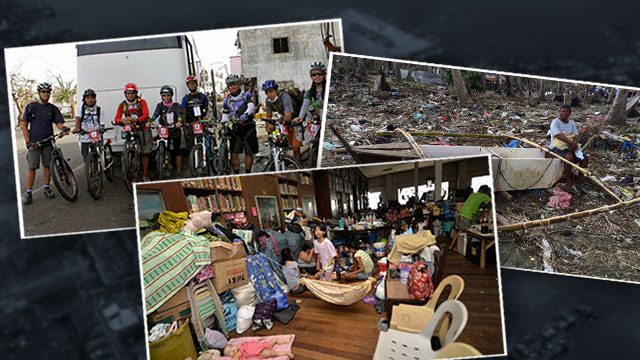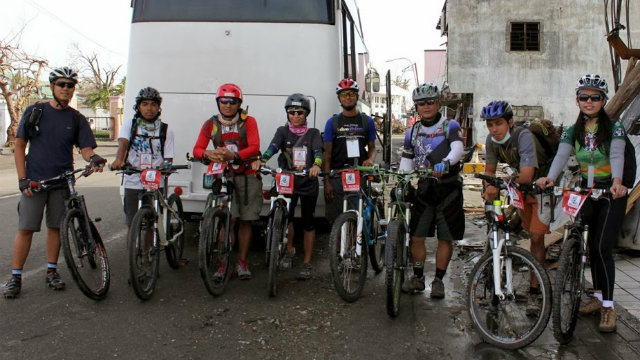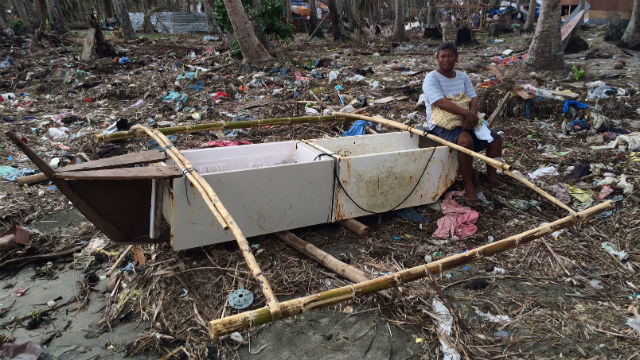SUMMARY
This is AI generated summarization, which may have errors. For context, always refer to the full article.

MANILA, Philippines – Typhoon Yolanda was one of the most covered disasters in the world. International media was on it 24/7; Anderson Cooper even came here on assignment. Photos and video clips went viral after the disaster.
Stories about the alleged mishandling of the crisis, delays in relief and rehabilitation efforts, and the abject condition of many survivors hogged the headlines.
Resilient spirit
Despite the challenges, the survivors picked up the pieces and carried on. 2013’s word of the year should have been “resilient.”
Survivors did not have much of a choice, but their will to live and fight in the face of adversity is no less admirable.
The stories below are just a glimpse of the emotional catastrophe left in Yolanda’s wake, each embodying the vulnerability and strength of the Filipino spirit.
1. Sending help

Myles Delfin, a member of Bike Scouts Philippines, shared his experience riding through the ruins of Eastern Visayas as a volunteer messenger. With the region cut off from all forms of communication, the Bike Scouts served as middlemen between survivors and their relatives.
Messengers were challenged by the curfew and limited information given to them. Probably the most challenging part was realizing that sometimes, there was nothing they could do. But the joy in reuniting a family made each phone call, with good or bad news, worth the challenges.
2. The fight in Filipinos

(Read: The ingenuity of the Filipino spirit)
A month after the typhoon struck, Dr. Anton Mari Lim found fisherfolk already back on their feet, or rather, on the water, using refrigerators as make-shift bangkas (boats).
A co-founder of Yellow Boat of Hope, the author, and his team provided boats to help rebuild their lives. He also recounted experiencing depression after his first visit, but was uplifted by the survivors who continued to fight and hope despite losing everything.
From his experience, Lim realized that the strength of Filipinos remained “because this is the only option left.”
3. A journalist’s perspective

(Read: The baby in the backpack)
A journalist’s job is to speak for voices unheard, but they too have their own stories to tell. “There is no going home,” Patricia Evangelista wrote in this moving piece. She tried to make sense of the tragedy of the lives (and deaths) she encountered, admitting, “I can’t write about anything else.”
With eye for detail, haunting images of loss filled her narrative. In the end, one wonders if being spared from the storm is truly a relief.
4. Big courage in small packages

(Read: A small smile from Tacloban’s children)
After Yolanda hit Tacloban, several children were evacuated from the city. The remaining few that video journalist Anne Lagamayo found were orphans. Some lost their parents in the storm; others were abandoned.
The children sounded much older than they should, aware of responsibilities beyond their age. But outside her interviews, Lagamayo caught hints of the childhood they lost.
5. Gratitude

(Read: How do you say thank you in English?)
Unlike other accounts, this was not a story from the ground but a simple encounter between the writer, Paolo Mangahas, and Turkish diplomats.
The international community was magnanimous in providing aid to the country. The Turks were one of those who have been generous and sympathetic to our plight. Mangahas expressed gratitude to the diplomats on behalf of the Filipino community. With this, both experienced a moment of humanity that transcended language.
Making sense of it
By no means should one be limited to these snippets of reality. It is easy to feel emotionally paralyzed by the stories, but they should also inspire and even enrage us. There is still much to be done in rebuilding the region and preventing this scale of loss.
It is difficult to understand why this happened.
Typhoon Yolanda was a reminder to the world of the violent force of nature. But there is no proper way to explain why a child should lose a mother, or why a father should bury his child.
A quote from Japanese author Haruki Murakami captured how even if nothing made sense, the most ordinary of people could become extraordinary in adversity:
“And once the storm is over, you won’t remember how you made it through, how you managed to survive. You won’t even be sure, whether the storm is really over. But one thing is certain. When you come out of the storm, you won’t be the same person who walked in. That’s what this storm’s all about.” – Rappler.com
Niña V. Guno is a 5th year AB Communication Arts and BS Business Management student from De La Salle University. She is a member of Tulong sa Kapwa Kapatid, a non-profit group that mentors less fortunate children in Payatas, Quezon City. She currently an intern at Rappler.
Add a comment
How does this make you feel?
There are no comments yet. Add your comment to start the conversation.